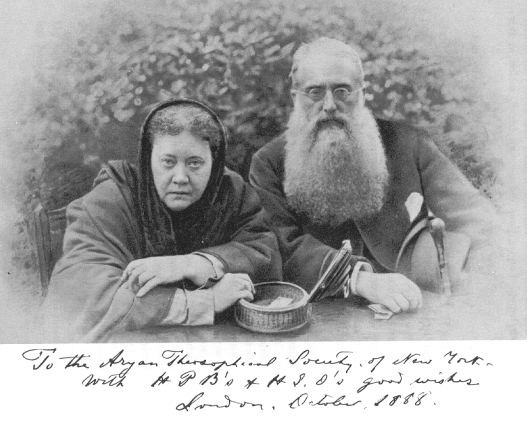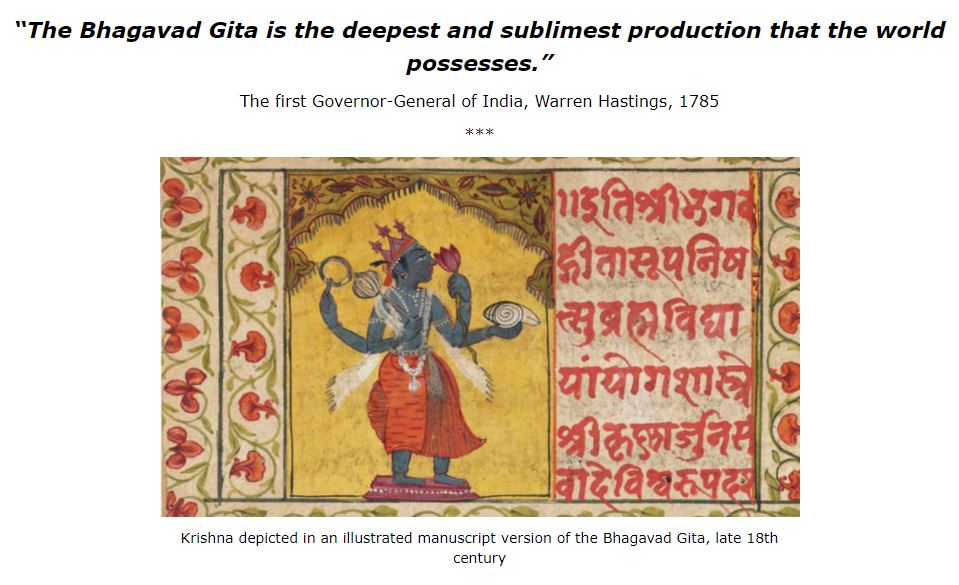‘I hesitate not to pronounce the ‘Geeta’ a performance of great originality, of a sublimity of conception, of reasoning, and diction, almost unequalled, and a single exception, among all the known religions of mankind.’
– Warren Hastings in the Introduction to the First-ever English Translation of the Bhagavad Gita (4- 10- 1784)
***
The following is from:
Modern Intellectual History, 7, 2 (2010), pp. 297–317 C doi:10.1017/S1479244310000089
Cambridge University Press 2010
Corrigibility, Allegory, Universality: A History of the Gita’s Transnational Reception, 1785–1945∗
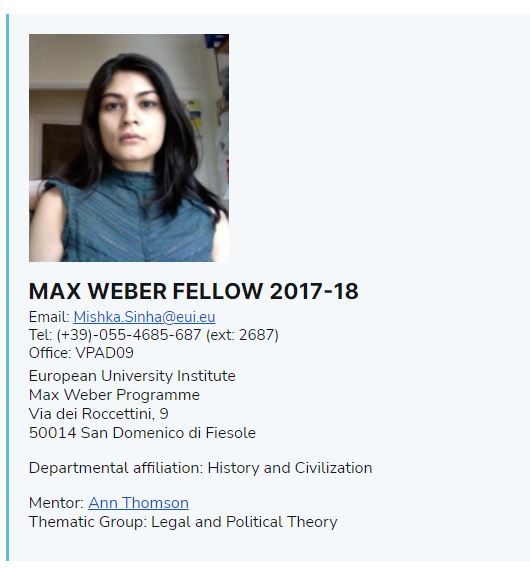 Mishka Sinha Faculty of Asian and Middle Eastern Studies, University of Cambridge
Mishka Sinha Faculty of Asian and Middle Eastern Studies, University of Cambridge
E-mail: mishka.sinha@gmail.com
***
This essay lays out a history of the translation, interpretation, transmission and reception of the Bhagavad Gita as a cultural, religious and philosophical text in the West from 1785 to 1945; in doing so it focuses primarily on Britain, although it also refers to other contexts of reception where they are connected to the British context, or to present revealing or helpful comparisons. The object of the essay is to investigate relationships between the Gita’s interpretive history and assumptions about the Gita, both as a transcultural philosophical source and as an essentially Hindu religious text, which have been in place since the twentieth century. Although there have been other transnational surveys and histories of the Gita’s translation, this essay differs from them in positing a specific period of interpretation between the end of the nineteenth century and the beginning of the twentieth, during which time, it argues, the Gita as a received and translated text was significantly altered in certain specific ways which continue to influence its present understanding both in the West and in India.
p. 300
The Early History of Translation
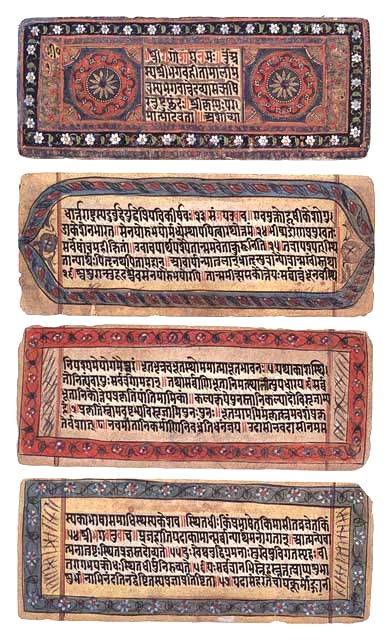
 When Charles Wilkins translated the Gita into English in 1785,undertheaegis of the East India Company, it amounted to a paradigm shift in the history of the interpretation of the Gita and the intellectual history of Western knowledge of the East. Wilkins’s translation “carried the text over”10 into a new cultural context, giving it unprecedented scope for an extraordinary breadth of meaning and influence.
When Charles Wilkins translated the Gita into English in 1785,undertheaegis of the East India Company, it amounted to a paradigm shift in the history of the interpretation of the Gita and the intellectual history of Western knowledge of the East. Wilkins’s translation “carried the text over”10 into a new cultural context, giving it unprecedented scope for an extraordinary breadth of meaning and influence.
Wilkins’s Bhagavat Geeta or the Dialogues of Kreeshna and Arjoon was the first text widely known to have been directly translated from Sanskrit into a European language.11 The Bhagavat Geeta was thus received in Europe with curiosity and interest as the first textual example of Indian culture directly encountered there. The curiosity occasioned by the Gita was to be its defining characteristic for most of its first hundred years in the West. As a result, its content was eclipsed by the novelty of its context and the popular interest in the language and culture of recently acquired British territories in India.
Charles Wilkins and Warren Hastings, Governor General of Bengal from 1773 to 1785, and chief supporter and instigator in Wilkins’s Sanskrit researches, began their comments on the Bhagavat Geeta by emphasizing its “curiosity” as a cultural object. They surmised correctly that this aspect would ultimately prove the most significant attraction for their readers in England.12
9. The boundaries of this “universality” depend on the interpretive context – for example, whether they extend to include all Hindus, or all Indians, or all humans. 10. Taking the Latin word translatio. 11. Charles Wilkins, Bhagvat Geeta or the Dialogues of Kreeshna and Arjoon (London: Nourse, 1785). 12. See p. v of Hastings’ “Introduction” and p. xvi of Wilkins’ “Translator’s Preface”, in the 1849 reprint of the original text, edited by Rev. J. Garrett.
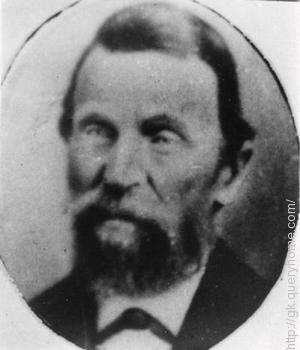
Hastings and Wilkins’s attempts to provide a wider sense of the text’s value as literature and as philosophical doctrine within its own cultural context13 found a largely hostile reception in answer to their apparent proposal to “exchange the most metaphysical of … [their] … own received doctrines, for others so much more abstruse, that the utmost stretch of mind on this hemisphere cannot comprehend”.14
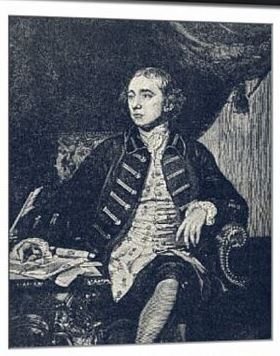
For early readers the primary value of texts retrieved from the unkown past of the distant East lay in their ability to convey pleasure and pique curiosity by emphasizing the difference between their readers and the people who produced them. As an early review put it, in the “history of the human mind, our curiosity is irresistibly attracted by those pages, which exhibit manners and opinions far removed from our own [to which] we liken with peculiar pleasure”.15 Ultimately, its reviewers reckoned, the Gita’s importance lay not in any intrinsic quality it may have possessed, but in its value as “a curious specimen of mythology and an authentic standard of the faith and religious opinions of the Hindoos”.16
Despite a favourable initial reception, Wilkins’s translation did not achieve lasting popularity in its early decades. In 1846, the editor of a multi lingual edition of the Gita which had been produced for missionaries in India observed that his own book filled an important gap, since, despite its being long held in high repute, the English translation of the Gita had now become scarce.17
The wider audience for Wilkins’s work in Britain, apart from those with scholarly, missionary or commercial interests in India, was an important section of the literate public. Until well into the second half of the eighteenth century the majority of this readership was primarily interested in traveller’s tales, however wild and fanciful.18
13. “Remarks on the Dialogues of Kreeshna and Arjoon”, Gentleman’s Magazine LV/12/2 (Oct. 1785), 955–7. 14. Anonymous review, Gentleman’s Magazine 55/12 (December 1875), 955–7, 957. 15. Monthly Review 1 (1785), Article II, 198–210 and 295–301. 16. Ibid. 17. Rev. J. Garrett, ed., The Bhagavat Geeta or Dialogues of Krishna and Arjoon in Eighteen Lectures. Sanskrit Canarese and English in Parallel Columns. The Canarese newly translated from the Sanskrit, and the English from the translation by Sir Charles Wilkins (Bangalore: Wesleyan Mission Press, 1846). 18. See, for example, J. Z. Holwell’s Interesting Historical Events, Relative to the Provinces of Bengal, and the Empire of Indostan, 3 vols. (London, 1765–71).
Yet their guaranteed audience was equally an indication of an eclectic curiosity about the manners and customs of non-Christian peoples and faraway lands, which was broadened and educated by the literary and linguistic discoveries of the late eighteenth century, but which, by the 1830s, was on the decline.19 After Macaulay’s crucial 1835 “Minute on Indian Education”,20 with few exceptions, academic and scholarly interest in India also lost ground, as the ascendancy of evangelical groups and Utilitarian ideals, and the influence of James Mill, shaped the temper of British intellectual attitudes to India.21
In this, Britain was the exception in nineteenth-century Europe, and even though the scholarly pursuit of Sanskrit studies and Indology in America was established later than in Europe, there, too, intellectual and cultural interest in India increased throughout the century. However, despite being the first Sanskrit text to be widely accessible in the West, the Gita was easily outdone in its impact in Europe as well as in America, in the early period of Western translations from Sanskrit, by Sacontala or the Fatal Ring, William Jones’s translation of Kalidasa’s play, published in 1789. Jones was one of the earliest European scholars to note the correspondences between Sanskrit, Greek and Latin, and to suggest a common origin for these languages.22
19 This is well illustrated by the diminishing numbers of articles on India in British journals, such as the Edinburgh Review,for instance,from theearly 1800stothe1830s.
20. T. B. Macaulay was a Whig politician, historian, and, from 1834,memberoftheSupreme Council of India. His “Minute on Indian Education” (1834) persuaded the Governor-General to adopt English, rather than Sanskrit or Arabic, as the medium of instruction in higher education in India. The Orientalists, including scholars and government officials such as H. H. Wilson, had maintained the importance of instruction in Indian languages, and of the need to educate Indians about their own texts and traditions. Macaulay, who was unversed in oriental studies, argued that modern European knowledge was superior to Asian knowledge, and that proficiency in English would be of greater benefit to Indians than Indian languages. Macaulay’s minute laid the foundation for higher education in India as well as a colonial system based on the cooperation of English-speaking Indians: it also catalysed the sharp decline in the value assigned to Indian languages, culture and history in Britain for the next century and more.
21 James Mill, The History of British India (London: Baldwin, Cradock and Joy, 1817).
22 Jones was one of the earliest scholars known to have noticed the philological relationship, although it may have been noted previously by medieval scholars working in Persian or Arabic. There is at least one European contender for Jones’s status: see John J. Godfrey, “Sir William Jones and Pere Coeurdoux: A Philological Footnote,” Journal of the American Oriental Society 87/1 (Jan.–March 1967), 57–9.
The idea of an Indo-European “mother-tongue”, with Sanskrit as the favoured contender, shaped the course of nineteenth-century oriental studies, seeding a new “science” of comparative philology which became a defining scholarly enterprise for a century absorbed with questions of origins, and interconnections between language, race and culture. The early fascination with classical texts such as Sacontala was replaced by a deepening obsession with the older literature of the Vedas and Vedanta, fuelled by the publication of the Oupnekhat (1802–4), a Latin translation of the Upanisads by the French Jesuit philologist Abraham-Hyacinthe Anquetil Duperron.23
23 Anquetil-Duperron’s version was based on the Persian translation written or commissioned by Dara Shukoh.
The Gita had neither the literary polish and skilful composition of classical literature, nor the sublime metaphysics of the Vedas, with their aura of grand antiquity, and hence remained for three-quarters of a century both less well known and less frequently translated than these.
Wilkins’s English translation was retranslated into Russian and French and soon after into German and Greek. However, the earliest direct translation from Sanskrit into German was not published until 1834, whilst the first direct French translation was done in 1861 by Emile Burnouf, the less-famous younger brother of Eugene Burnouf, Sanskrit professor at the College de France. 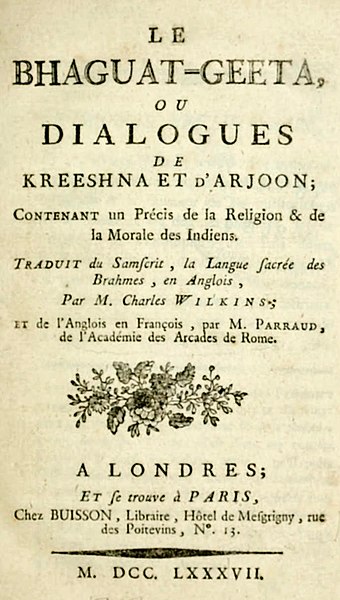 The first direct translation of the Gita into a European language after Wilkins’s was by August von Schlegel, who held the first chair in Sanskrit in Germany. Schlegel published a Latin translation of the Gita in 1823 along with the first critical edition in Sanskrit by a European. Unlike Wilkins’s Gita, Schlegel’s critically edited text represented a scholarly tradition of interest in Sanskrit and Indian philology and philosophy which had come of age. Schlegel’s text showed that Wilkins’s translation contained several inaccuracies, yet it was not followed by a new English translation for seventy years.
The first direct translation of the Gita into a European language after Wilkins’s was by August von Schlegel, who held the first chair in Sanskrit in Germany. Schlegel published a Latin translation of the Gita in 1823 along with the first critical edition in Sanskrit by a European. Unlike Wilkins’s Gita, Schlegel’s critically edited text represented a scholarly tradition of interest in Sanskrit and Indian philology and philosophy which had come of age. Schlegel’s text showed that Wilkins’s translation contained several inaccuracies, yet it was not followed by a new English translation for seventy years.
The “recovery” of Sanskrit and its literary corpus and traditions for the West by the East India Company became a symbol of both British political and economic power and the ability and authority it conferred to gather for Western civilization not only material largesse but also fabulous cultural wealth. The most vivid con-temporary representation of the symbolic power of Sanskrit translation, and of the Bhagavad Gita as the exemplar text brought forth by this power, was in William Blake’s drawing The Brahmins (1809), which showed Charles Wilkins working on his translation of the Gita with a group of Brahmins attendant upon him.
Blake’s drawing suggested that the importance of the Gita lay in its significance as an object of secret knowledge recovered through intellectual labour and imperial triumph from its hitherto unknowable form within a previously hidden tradition. With few exceptions, for most of the first hundred years after it became available in the West, this summed up the major significance of the translocated Gita in its international context.
Metamorphoses of the Gita: 1880–1910
In the almost hundred years between 1785 and 1880,there were two extant translations of the Gita in English, Charles Wilkins’s, and one brought out in 1855 by J. Cockburn Thomson—a former student of H. H. Wilson, the first Boden Professor of Sanskrit at Oxford. In the five years between 1880 and 1885 three new translations in English were published in Britain.
The steep increase in the number of translations of the Gita from the final decades of the nineteenth century onwards reflected an unprecedented expansion in its popularity and influence. This was a result of a series of independent and yet in some ways related translations and interpretations of the Gita which, in conjunction, transformed its meaning and interpretation for the modern world. The effects of this transformation were as vital to the reception of the Gita in India as they were in the West.
Although there were other popular translations of the Gita during this period, they did not, in my opinion, contribute as much as did the four described below to the Gita’s modern metamorphosis, nor did they reflect the qualities which may be taken as family resemblances appearing in, and connecting, these four interpretations, each of which is integral to modern interpretations of the Gita: the emphasis on allegory, the assumption of universality, and the presence of a dialogic communication between Indian and Western interpreters which shape these interpretations.24
Sacred Books of the East
The Bhagavad-Gıta ,translated by Kashinath Trimbak Telang, was published in 1882 in the eighth volume of the Sacred Books of the East, edited by Friedrich Max Muller. In the 1870s, when the series commenced, there was a growing public appetite for doctrines which could provide frameworks for the movements of heterodox spirituality that rose in an implacable tide at the end of the nineteenth century. Publishing houses recognized a new and profitable market, and K. Paul, Trench, Trubner and Company was an early player in the game, publishing The Sacred Anthology: A Book of Ethical Scriptures,25 edited by Moncure Conway, and dedicating a specialized Oriental Series to literary and religious texts from Eastern traditions.
24 The only exception is Swami Vivekananda’s interpretation of the Gita in lectures delivered in Europe, America and India, which shares these characteristics. However, Vivekananda’s Gita was more important to the reception of the text within neo-Hindu movements in India than in a transnational context.
25 The Sacred Anthology: A Book of Ethical Scriptures Collected and Edited by Moncure Conway (London: Trubner and Company, 1873).
Max Muller’s choice of the term “sacred books” had a special significance for the inclusion of the Gita in the series. Rejecting the word “Bible” as a generically applicable term, and describing his search for a broader one, Muller stressed an important distinction: “there are many books sacred which are not canonical, and it was in order not to exclude them from my Series, that I prefer the title Sacred Books of the East”.26 This was an important difference since Muller could not have included the Gita or the Visnupurana in his series had they had to fit the category of canonical. Muller, like his nineteenth-century German teachers, saw authority and importance as inextricably connected with age and antiquity. In a letter to William Gladstone, Muller wrote that he wished to direct the other’s interest to the “real India”, in which lay the primitive origins of European culture:
It was a misfortune that all the early publications of Sanskrit texts belonged really to the Renaissance of Sanskrit literature …[the] older literature in India, the Vedic and the Buddhistic …is [where] …we can watch a real growth from the simplest beginnings to the highest concepts which the human mind is capable of . . .27
Yet while it was not canonical, nor vital to the understanding of India, in Max Muller’s estimation, the Gita was sacred in the Sanskrit tradition, and hence, despite not being especially interesting to most nineteenth-century scholars, it was included in the series.
Kashinath Trimbak Telang had previously published a verse translation of the Gita in Bombay, but the version for the Sacred Books was in prose, and included the Anugıta and the Sanatsug atıya. Telang was one of only three non-Western contributors invited to write for the series, and one of two Indians, the other being the celebrated R. G. Bhandarkar. Most other contributors were internationally recognized scholars while Telang was comparatively obscure. Telang’s translation combined a thorough knowledge of the Sanskrit tradition with a philological and historical method very much part of a nineteenth-century European mode of scholarship; it was meticulous and scholarly, but lacked significant literary or poetic qualities that might have drawn a wider audience. Yet Telang’s Gita turned out to be amongst the more popular books in the series, selling over two hundred copies.28
Forty-nine volumes of Sacred Books were eventually published in two series between 1879 and 1910. The cost of publishing this extraordinary and expensive project was borne by Oxford University Press together with the British Government in India.29
26. Friedrich Max Muller, The Life and Letters of the Honourable Friedrich Max Muller in Two Volumes Edited by His Wife (Bombay, London and New York: Longmans, Green and Company, 1903), Muller to Moncure Conway, 5 Jan. 1883, 2: 135.
27. Muller to W. E. Gladstone, 18 Jan. 1883, Life and Letters, 2: 138.
28. N. J. Girardot, “Max Muller’s ‘Sacred Books’ and the Nineteenth-Century Production of the Comparative Science of Religions”, History of Religions 41/3 (Feb. 2002), 227 n. 27.
29. Muller, Life and Letters, 2: 10.
To foreground and frame the special nature of his project, Max Muller, as a member of the board of delegates at the press, suggested that a new category of publications be instituted which would be published not for profit but for the “advancement of sound learning”.30 The Oxford Clarendon Press was accordingly instituted.
It is important to further contextualize Max Muller’s project, and the new authority it conferred on the Gita, by its inclusion in another emergent institutional innovation. The transformative integration and reconstitution of oriental studies within British institutions of higher education occurred as part of a larger transformation taking place in the medieval British universities and British academia at this time. The important changes in academic institutions in America during the nineteenth century followed the development of professorial “research” universities in Germany.31 In Britain, the 1870s, when Max Muller had reached the height of his academic and social influence, was the cusp of the change; taking Oxford as the exemplar, “there was a dramatic passage from the restrictive Anglican clerical, classical, and upper-class trappings of traditional education to a newly liberalized, nationalistic, competitive, and middle-class professional system”.32
Telang’s Gita received few public reviews. The reviewers of The Song Celestial, published three years later, all noted previous translations of the Gita by Wilkins, Cockburn Thomson and John Davies (1882); yet although Arnold himself mentioned Telang’s translation as well as the other three, none of Arnold’s reviewers mentioned Telang. The only reference I have found in contemporary popular journals and newspapers to Telang’s Gita is a piece of witticism in a brief article entitled “
A Serious Series”: A “Series of Sacred Books of the East,” edited by Professor Max Mueller, is now being published. One of the volumes contains the Satapatha-Brahmana according to the text of the school of Madhyandin; another comprises the “Pattimokkha” (who was he bye-the-bye and why did he mock Patti?); while in volume eight is found “The Bhagavadgita with the Sanatsugatiya, and the Anugıta” translated by Kashinath Trimbak Telang, M.A. Fancy sending your servant to a bookseller’s to ask for such works! Why, she would be sure to drop half a dozen syllables on the road.33
30. Girardot, “Max Muller’s ‘Sacred Books’”, 228 n. 29. See Max Muller, “Statement to the Delegates of the Oxford University press, 1878,” OUP Archive.
31. Girardot, “Max Muller’s ‘Sacred Books’”, 215–16.
32. Ibid., pp. 215–216.
33. Funny Folks, 3 June 1882.
Was the general reader disconcerted by the strange syllables composing Telang’s name which added to the unfamiliarity of the Gita, or were the “serious” scholarly trappings of the text not suited to a mass audience? Notwithstanding its reception, through being included in the Sacred Books, Telang’s Gita was absorbed into an integrated institutional structure which altered the text’s presence in its international context. The Sacred Books represented a highly ambitious academic, cultural and political publishing project. They were selected by Max Muller to represent a specific construction of sacredness that conferred upon the texts he included a separate kind of social, cultural and institutional authority which they reciprocally manifested and defined.34 Published within such a structure the Gita became part of a new transnational, established and authorized canon that could foundationally define what constituted an internationally recognized sacred tradition.
The publication of the Gita in the Sacred Books was a collaborative process involving an Indian translator and a Western figure of institutional authority as well as immense popular authority on India. Their dialogical interaction gave the Gita a new universal sanction.
The Song Celestial
Edwin Arnold’s translation, The Song Celestial, allowed the Gita to enter a broader public consciousness. Arnold’s poem was in the grand tradition of Dryden’s translation of Virgil, which brought the original closer to the reader, rather than bringing the reader closer to the original, as Goethe had suggested should be done to maintain fidelity while translating oriental texts. Rather than attempt to reproduce the Gita “as it was”, The Song Celestial reinvented and, in some contexts, replaced it.
By the time the Song Celestial appeared in 1885, Edwin Arnold was already a highly regarded Victorian poet, well known for his oriental verse. In a Liverpool newspaper, published on New Year’s Eve 1885, The Song Celestial is mentioned under the Literature Section of a listing of the past year’s important events, appearing beside works by Tennyson, Swinburne and George Meredith.35
34. This is noted by Girardot, “Max Muller’s ‘Sacred Books’”, 220.
35. “The Year 1885”, Liverpool Mercury, 31 Dec. 1885.
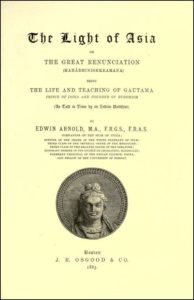 Arnold’s most popular work was The Light of Asia (1879), and although The Song Celestial never matched the popularity of the earlier poem, Edwin Arnold played an essential part in the transformation of the modern Gita. Arnold had been principal of the Government College in Pune, before a successful journalistic career in London with the Daily Telegraph where he rose to the position of editor-in-chief. Yet his prominent public image arose from his involvement with two grandly ambitious and acquisitive colonial projects: the journalistic assignment of H. M. Stanley which he helped to arrange, and his promotion of a proposed Grand Trunk railway across Africa.
Arnold’s most popular work was The Light of Asia (1879), and although The Song Celestial never matched the popularity of the earlier poem, Edwin Arnold played an essential part in the transformation of the modern Gita. Arnold had been principal of the Government College in Pune, before a successful journalistic career in London with the Daily Telegraph where he rose to the position of editor-in-chief. Yet his prominent public image arose from his involvement with two grandly ambitious and acquisitive colonial projects: the journalistic assignment of H. M. Stanley which he helped to arrange, and his promotion of a proposed Grand Trunk railway across Africa.
The Song Celestial garnered public notices across England and Ireland, many of which noted Arnold’s contribution in making Eastern texts accessible for a newer, broader audience. A reviewer in the Birmingham Daily Post wrote,
In an especial sense Mr. Arnold has been a revealer to his generation. To what extent …Oriental literature [has] …been accessible to the learned among us we do not know; but to the mass of the English reading public they [oriental works] have been as though they were not …Mr. Arnold has in mellifluous verse placed before us …some of the works of utmost popularity and authority in the East …He now adds this noble poem . . .36
But the demand for oriental works amongst “the mass of the … reading public” was rising; as the Freeman’s Journal, published from Dublin, remarked in August 1885,
Undoubtedly Eastern Literature is being popularized, a taste for its study is rapidly developing. In recent years, books …have unlocked the closed doors of Indian philosophy and literature …Of the present poem, the Bhagavad Sita [sic] of the great Hindoo epic, the Mahabharata—there are already three English translations …But …Mr. Arnold brought to his task literary acquirements …supplemented by …special knowledge as an Orientalist . . .37
By the end of the century the Gita, in the form of The Song Celestial, had become a naturalized Victorian text. In December 1899, M. H. Gill and Son, a Dublin bookseller, posted in a local paper recommendations from amongst its collection of books especially “[s]uitable for Christmas Presents”. The Song Celestial, at two shillings, was among the most competitively priced of those listed.38 Unlike the reviewer of Wilkins’s Gita, who had thought the primary function of The Bhagavat Geeta to lie in satisfying its readers’ curiosity about the exotic East, one hundred years later a reviewer of The Song Celestial saw it as a book for a spiritual truth-seeker, irrespective of religion or culture. Yet the poem is also simultaneously read as a text whose pleasure lies in its value as an aesthetic object. Both characteristics seemed to be easily reconciled within the Gita’s new identity:
The Song Celestial is not a book to be hastily read and thrown aside, and those who only want to be amused will do much better with a three-volume novel. But to the real enquirer, the searcher after truth, the profundity of the work will be as welcome as its rare finish and beauty will make it to those who are chiefly interested in literary excellence.39
36. Birmingham Daily Post, 13 Nov. 1885.
37 Freeman’s Journal and Daily Commercial Advertiser (Dublin, Ireland), 28 Aug. 1885.
38. “Advertisements and Notices”, Freeman’s Journal and Daily Commercial Advertiser (Dublin, Ireland), Saturday, 9 Dec. 1899,classified advertisements.
39 Freeman’s Journal and Daily Commercial Advertiser (Dublin, Ireland), Saturday, 9 Dec. 1899.
Yet high Victorian evangelism was still a part of late nineteenth-century Britain. Suspicion of and even revulsion towards Hinduism existed side by side with the enthusiasm for alternative spiritual paths and the lingering Romantic fascination with the exotic. For many who recalled the darker rumours about contemporary Hinduism, Edwin Arnold’s task was to rescue the better portion of Hindu philosophy from its unpleasant and even threatening context and present it, shorn of dubious associations, to his discerning public:
Mr. Edwin Arnold[’s translation] …will do more for the English reader than any amount of metaphysical or historical disquisition to open a way into the mysterious labyrinth of Eastern speculation. The grandeur of the forest, into which he clears a smiling pathway, conceals the confusing and noxious undergrowth where the unclean and venomous and ferocious forces are at work …[the text] does not introduce any of the well-known and popular and degrading forms of the Krishna legend . . .40
40. Leeds Mercury, 25 July 1885. .
Arnold’s poem allowed the Gita to be received by a new public audience. Within months of the appearance in print of The Song Celestial, the Leeds Public Library had announced it as one of their latest acquisitions.41
A large part of the new and growing readership of the nineteenth and the early twentieth centuries was composed of borrowers of books and journals from local libraries, and it was this audience, who would either not have had access to or simply not chosen to read previously available translations of the Gita, which received Arnold’s late-Victorian version with evident enthusiasm.
41 “Local Notes and Queries”, number CCCXL, Leeds Mercury, 18 July 1885
The text had become part of a common pool of reference, entering a kind of generalized literary consciousness in Britain. By means of Arnold’s poem, the Gita began to occupy a much more fluid space. It became capable of slippage, out of a specific cultural context and meanings bounded by that context, into a literary form, where it and its meanings could be read much more loosely, as allegory, its images taken as metaphors, and its religious, doctrinal elements as purely symbolic signifiers.
The Gita was no longer a “sacred” or religious text from a specific non-Western tradition, but something more universal. In its new form it could be received as poetry and a kind of non-denominational religious philosophy. The identifiably late-Victorian form and language endowed it with a new kind of life which drew it out of its older skin and contributed to its remaking as a chimerical, transcultural object.
Gandhi and the Song Celestial
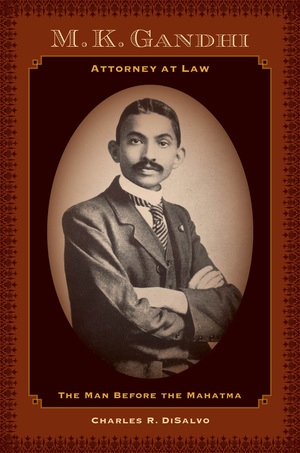
Arnold’s poem, The Song Celestial, gave the Gita a pan-Victorian identity which appealed not only to readers at home, but to converted readers from across the empire. While this essay has not the scope for a history of the Gita in the context of Indian nationalism and neo-Hinduism, there is an important link between Arnold’s poem and one of the most significant representations and uses of the Gita in India in the twentieth century—as Gandhi’s textbook of non-violence. This needs exploring here because of its role in the dialogic nature of the Gita’s transnational development, which comprehended Indian and Western interpretations and their integral consciousness of each other and affected the Gita’s modern interpretive history.
In 1925, Gandhi published an article on his interpretation of the Gita in his nationalist weekly journal, Young India, where he described his earliest encounter with the text. I quote it at length because it illuminates the significance of Arnold’s influence:
My first acquaintance with the Gita was in 1889,when I was almost twenty. I had not then much of an inkling of the principle of Ahimsa …Now whilst in England my contact with two English friends made me read the Gita …My knowledge of Sanskrit was not enough to enable me to understand all the verses of the Gita unaided …They placed before me Sir Edwin Arnold’s magnificent rendering of the Gita. I devoured the contents from cover to cover and was entranced by it. The last nineteen verses of the second chapter have since been inscribed on the tablet of my heart. They contain for me all knowledge …I have since read many translations and many commentaries, have argued and reasoned to my heart’s content but the impression that first reading gave me has never been effaced . . .42
42 M. K. Gandhi, “The Meaning of the Gita”, Young India: A Weekly Journal VII/46 (12 Nov. 1925), 385–6. 43 Ibid., 385.
The article is set out as a response to a question which had been raised about the true teaching of the Gita: whether it represents an injunction to violence or to non-violence. This is a question to which it was vitally important for Gandhi to provide a public answer, one which would effectively resolve in his own favour the struggle between his own ideology of non-violence and that of those nationalist leaders who sought to use the Gita to support their argument for necessary violence. Gandhi presented his case, entering the fray with a line that echoes one of the most popular injunctions of the Gita, to perform an action without attachment, nis.kama karma—“Mine is but to fight for my meaning, no matter whether I win or lose . . .”43 — a brilliant reminder of Gandhi’s commitment to the teaching of the Gita.
The extraordinary effectiveness of Gandhi’s argument in this essay lay in his willingness to read the Gita as a literary work, while he argued for the imposition of a singular interpretation (of non-violence) on a text which he presented as the central spiritual doctrine of his creed. He made it clear that he saw the Gita as allegory:
And who are Dhritarashtra and Yudhishtira and Arjuna? Who is Krishna? Were they all historical characters? …I regard Duryodhana and his party as the baser impulses in man, and Arjuna and his party as the higher impulses. The field of battle is our body. An eternal battle is going on between the two camps and the Poet seer has vividly described it. Krishna is the Dweller within, ever whispering in a pure heart.44
Gandhi emphasized the Gita’s origins as a literary production by a poet, rather than a religious revelation by a form of the Supreme Being. He argued for a critical reading of the Gita’s epic context and declared that the Gita’s meaning must not suffer from what formalist critics would call the “intentional fallacy”: the poem has a semi-mystical capacity to transcend its writer’s intended meaning. “You might … say that the Poet himself was not against war or violence … But … The poet … is not conscious of all the interpretations his composition is capable of. The beauty of poetry is that the creation transcends the poet”.45 While the Gita was interpreted allegorically before the nineteenth century, from this moment, with the influence of Arnold’s poetic representation, and, as we shall see, theosophical renderings, allegorical interpretations of the Gita were privileged over others, and Gandhi gave them defining currency.
In his autobiography, Gandhi wrote that the friends who introduced him to the Gita in the form of Arnold’s poem were Theosophists.46 They introduced Gandhi to Madame Blavatsky and Mrs Besant, and, although Gandhi “politely declined” his friend’s invitation to join the society, he read, “at … [their] instance, Madame Blavatsky’s Key to Theosophy.”47 Gandhi wrote of the book that it “stimulated in … [him] the desire to read books on Hinduism”.48 Gandhi’s version of the Gita shows evidence of his Theosophical readings as well as the influence of Edwin Arnold.
44. Ibid. 387.
45. Ibid., 386.
46. M. K. Gandhi, An Autobiography or The Story of My Experiments with Truth, trans. Mahadev Desai (Ahmedabad: Navjivan Book Trust, 1930), 35.
47. H. P. Blavatsky, The Key to Theosophy (London: The Theosophical Publishing Company and New York: W. Q. Judge, 1889). 48 Gandhi, Autobiography, 35.
The Theosophical Turn
The years between 1880 and the first decade of the twentieth century saw the emergence and structural and ideological consolidation of the Theosophical Society in America, India, Britain and continental Europe. Peter van der Veer has convincingly shown that the evangelical tendencies of the Victorian age, which were amongst the strongest influences on imperial culture and policy in the nineteenth century, were most radically opposed not by liberalism, which he accurately sees rather as sharing many evangelical premises, but by unorthodox religious movements, including spiritualism and Theosophy.49
49. Peter van der Veer, Imperial Encounters: Religion and Modernity in India and Britain (Princeton and Oxford: Princeton University Press, 2001), 59–60.
Many of these movements combined religious radicalism with strong political leanings towards various forms of nonconformist, antinomian sympathies, and anti-imperialist rhetoric. The Gita could be integrated by Theosophy as part of what appeared to be a radical spiritual quest which sought to achieve results well beyond merely spiritual realms.
The Theosophical Gita was the most important chapter in the formation of the transnational Gita—a modern, multi formed text which could be contingently comprehended according to interpretive contexts, and universally applied to global spiritual conditions, whilst remaining rooted to its essentialist origins in a fabulously reconstructed purely Hindu past. The Theosophical representation of the Gita placed it within a properly transnational context, being collectively constructed and publicized through the text’s interpretations by both Indian and Western members of the Theosophical Society. They included T. Subba Row, an early Indian initiate, whose lectures on the Gita in 1886, at Adyar, conjectured that Krishna in the Gita represented Logos, while Arjuna represented the monad, or man; Mohini Chatterji, whose translation of the Gita was published by Trubner in 1888; and William Quan Judge, secretary of the American section, whose Essays on the Gita (1890)presented an entirely allegorical interpretation of the Mahabharata.
There were two characteristics which, mutatis mutandis, tended to be present in all of the Theosophical Gita’s. These were, first, the assumption that the Gita was primarily an allegorical text to be symbolically interpreted, and, second, that it was a text of universal spiritual significance. These interpretive principles were apparent in Gandhi’s reading of the Gita’s and Edwin Arnold’s translation. They were also used in contemporary Hindu interpretations, such as Vivekanada’s, where the universal aspect took on a double significance: the Gita was simultaneously the universal Hindu text, the essence of Hinduism and as such pertinent to all Hindus, and an essential spiritual text for all humanity. However, the Theosophical adoption of these two interpretive principles gave them a far wider reach and significance in a much broader international context.
Annie Besant, Madame Blavatsky’s successor in Britain and India, used her allegorical reading of the text in the service of her political commitment, constructing an ingenious parallel between the Mahabharata war and the Indian freedom struggle. Instead of an internecine war for succession between close kin, the war in the Mahabharata became a struggle by Arjuna “to destroy a usurper who was oppressing the land; it was his duty as prince, as warrior, to fight for the deliverance of his nation and restore order and peace.”50
Besant’s interpretation, in her translation as well as her Hints on the Study of the Gita, was the most successful and most widely read of all the Theosophical Gitas. She used her influence to drive home the universalist assumptions which were by now becoming characteristic of the text: “To speak of the Gita is to speak of the history of the world … How great is the Song of the Lord, all nations with one voice acclaim … in every country [it] has awakened some echo in receptive hearts.”51
50. Annie Besant, The Bhagavad Gita or the Lord’s Song (Madras: G. A. Natesan and Company, 1907), iv. 51 Annie Besant, “First lecture”, in idem, Hints on the Study of the Bhagavad Gita (Adyar: Theosophical Publishing House, 1973), 1–2.
Theosophy’s impact was extraordinary not only because of its geographical spread, but also because it extended across multiple fields of influence: cultural, intellectual, aesthetic and, crucially in the case of India, political. The Gita became a central text of Theosophy and through its intercession the Gita could reach a transnational, transcultural audience, acquiring new, spectacularly effective, forms and meanings in the West as well as in India.
Edwin Arnold’s translation of the Gita showed that a literary representation, with the characters as archetypes or abstract ideals, and the action as purely symbolic, was the most easily communicable and widely acceptable telling of the text. Gandhi and the Theosophists followed where he had led and found the allegorical method apt to their requirements. Through the continuing impact of interpretations on generations of new readers and translators, these characteristics would become part of the essential meaning of the text for interpreters from India and the West, as the Gita gained ever-growing popularity from the end of the nineteenth century into the twentieth.
The Gita in the Twentieth Century
Two translations of the Gita in the twentieth century reveal the influence of the inherited ideas and interpretations from the nineteenth century. Each is the product of collaborations between Indian and Western translators, and the authors of each unquestioningly accept the assumption of universal relevance that the Gita began to acquire in the period between 1880 and 1910. Both translations were concerned with the symbolic possibilities of the text; however, the interpretation accompanying the second translation represents the culmination of the process begun by the literary and allegorical interpretations of Arnold, Gandhi and the Theosophists, by turning the ordinary, surface meaning of the Gita on its head.
The two collaborative translations of the Gita which are the subjects of this section appeared in 1936 and 1944. Each could lay claim simultaneously to the spiritual authenticity of the East, and the cultural authority of the West, by bringing together Indian translators—Hindu swamis visiting the West—and prominent Western authors.
In 1931, W. B. Yeats met Purohit Swami through Thomas Sturge Moore, who hoped to garner Yeats’s support for the swami’s book on his spiritual experiences as an “Indian monk”. Yeats was impressed by the swami’s descriptions of his own transcendental experiences, and agreed to write an introduction for the book.52 Yeats now took on the task of helping the swami to publish further books; he approached Faber and Faber, where T. S. Eliot was editor, hoping that Eliot would publish the swami’s books and provide introductions for them, endowing them with inestimable value in an international market. In the literary world of modernist London, T. S. Eliot had a special status, as an interpreter of arcane knowledge, as well as an authority, amongst Western writers and critics, on Hindu and Buddhist philosophy. However, Eliot was not convinced about the marketability of the swami’s books. In a letter to Purohit Swami written in 1934, Eliot wrote that he was not sure he believed all the swami’s tales of Indian mysticism, and was even less sure of what a British audience would think of them. About the Gita, he added,
to the ordinary occidental reader who has no first hand experience of Indian thought, and no real perception of the seriousness of the subject, the Bhagavad-Geeta is likely to seem at first sight repetitious and prolix. I believe that it might seem so to me, if I had not many years ago read it in the original.53
Despite Eliot’s reservations, Faber took on the publication of four books by Purohit Swami, apparently on the condition that they be either introduced by or in some way associated with the name of W. B. Yeats.54 Apart from an anonymous review of Yeats and Purohit Swami’s translation of The Ten Principal Upanisads, in a Faber catalogue for 1937,Eliot did not provide a written endorsement of any of the swami’s books.55 He did not write an introduction to Purohit Swami’s translation The Geeta, despite there being evidence that one was expected from him by the Faber directors.56
52. Purohit Swami, An Indian Monk (London: Macmillan, 1932).
53. T. S. Eliot File, Purohit Swami Collection, Nehru Memorial Archives, Delhi (unpublished letter from T. S.
54. Eliot to Purohit Swami, 1 Nov. 1934). T. S. Eliot File, Purohit Swami Collection, Nehru Memorial Archives, Delhi (unpublished letter from T.S. Eliot to Purohit Swami, 7 May 1937).
55. The Ten Principal Upanishads, trans. Purohit Swami and W.B. Yeats(London:Faber,1937). The Geeta: The Gospel of the Lord 56 Shri Krishna, trans. from the original Sanskrit by Shri Purohit, Swami (London: Faber, 1935).
Eliot and Yeats exemplified in turn two kinds of response to the Gita in the West—the scholarly, which had been more prominent for most of the nineteenth century, and the popular, which rose to dominate the field from the 1880s.
Yeats devoted much of the energies of his last years to the publication and promotion of Purohit Swami’s work. Introduced to Hinduism by an Indian Theosophist in 1886, Yeats was later a member of the Theosophical Society for a number of years. From an early age, Yeats had sought initiation into a spiritual path which would lead him to revelations of arcane mysteries and mystical truths which he believed to exist on a hidden plane, a spiritus mundi, which was everywhere and yet not apparent. His interests in Theosophy, spiritualism and Purohit Swami’s books were all motivated by this search. He was far less concerned with the scholarly accuracy of the swami’s translations than with the spiritual truths they seemed to embody, an attitude which characterized the popular tradition of interest in Hinduism and its texts, with its fluid and amorphous synthesis of influences and ideas.
On the other hand, Eliot inherited his approach to Indian philosophy and its texts from his teachers at Harvard, who treated them as scholarly sources, to be understood within a specific cultural and religious context. Despite poetic references to the Gita in the Four Quartets and in an unpublished section of The Waste Land, as well as a statement that he believed the Gita to be the next greatest philosophical poem after Dante’s Divine Comedy, Eliot did not want to be involved in the production of a popular translation of the text. Unlike Yeats, he was not convinced that the Gita’s proselytization in the West as a generalized or universal spiritual doctrine was either desirable or possible. While Yeats accepted the late nineteenth-century idea of the Gita as a universal text which was full of symbolic significance, an aspect which appealed to Yeats’s occult proclivities, Eliot remained unconvinced by the idea of a universal religion. Amongst most twentieth-century western readers of the Gita, Eliot was increasingly in the minority.
In 1944 the Gita appeared in a translation by Swami Prabhavananda and Christopher Isherwood.57
57. The Song of God: Bhagavadgita, trans. by Swami Prabhavananda and Christopher Isherwood, with an Introduction by Aldous Huxley (Hollywood: M. Rodd Co., 1944).
Like Purohit Swami, Prabhavananda had travelled west to proselytize Hinduism. It was a tradition which may have had its earliest success in Swami Vivekananda, but its most influential and effective representative came later in the person of A. C. Bhaktivedanta and his International Society for Krishna Consciousness. Prabhavananda gathered a circle of influential acolytes around him in California. One of these was the English novelist, Aldous Huxley, who introduced Christopher Isherwood to the swami. Isherwood and Prabhavananda’s translation of the Gita was one of several collaborations undertaken by the swami with various Western writers. Yet The Song of God had a special advantage. As well as being co-authored by a famous author, it carried an introduction by the even more celebrated Aldous Huxley.
Huxley’s Introduction to The Song of God became as famous as the book for which it was written. In it, he expounded the principles of a universalist spiritual tradition he called the “perennial philosophy”, of which he claimed the Gita to be an exemplar text:58 “In Vedanta and Hebrew prophecy, in the Tao Teh King [sic] and the Platonic dialogues … the Perennial Philosophy has spoken almost all the languages of Asia and Europe and made use of the terminology and traditions of every one of the higher religions”.59
The universality of the Gita was re-emphasized through its representation as part of the “perennial philosophy.” It was the “compendium of the whole Vedic doctrine … the focus of all Indian religion”,60 but contained “enduring value”, “not only for Indians, but for all mankind”.61
Through its inclusion in this new paradigm, the Gita could now function paradoxically both as a central symbol of neo-Hinduism, and as an exemplar text of a transnational universalist philosophy and spirituality.
Aldous Huxley’s Introduction brought to light the distance travelled by the Gita from its original literary and spiritual context, and illustrated the breadth of possible meanings which could be assigned to it, and the Gita’s amenability to allegorical interpretation was taken by Huxley to its utmost limit:
“The Bhagavad-Gita is perhaps the most systematic scriptural statement of the Perennial Philosophy … [for] a world at war … it stands pointing, clearly and unmistakably, to the only road of escape from the self-imposed necessity of self-destruction.”62.
Writing in the midst of a war of destruction and violence on an unprecedented scale, Huxley reread and reimagined the Gita in a role which not only subverted its prime injunction to kill, and accept the necessity of killing, but converted it into a pacifist manifesto, a means of escape from violence.
58. The next year, Huxley published The Perennial Philosophy (London: Chatto and Windus, 1945), devoted to explicating its history and underlying principles. 59 Aldous Huxley, “Introduction”, Song of God, 11–12. 60 Ibid., p. 13. Huxley quotes Ananda Coomaraswamy on the Gita. 61 Ibid. This is Huxley’s own conclusion. 62 Ibid., 23.
conclusion
Telang’s Bhagavadgita, published in Max Muller’s Sacred Books, Edwin Arnold’s The Song Celestial, the loosely connected Theosophical interpretations with their family resemblances, and Gandhi’s Gita, which drew from Arnold and the Theosophists, all these, published between 1880 and 1910,individually and in succession contrived a hegemonic form for a transnational Gita. Each contingently contributed to an interpretation which emphasized its allegorical qualities and symbolic significance and its universal relevance. As the final section has shown, the majority of translations that followed were to assume these qualities to be intrinsic as well as essential to the text. In some sense the horizon forming the historical consciousness of these previous translations has been blurred into the horizon of the text itself within the consciousness of modern readers and interpreters of the Gita.
Also see:
